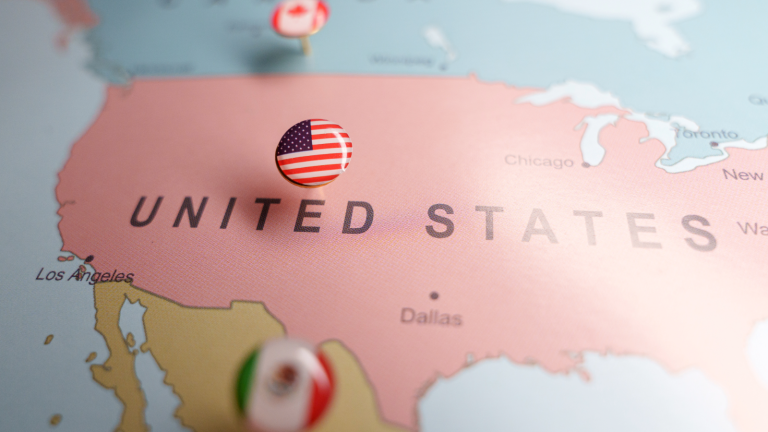There’s one word that has the uncanny ability to put Wall Street on edge these days.
Utter it once, and investors are spooked. Markets are thrown into a tailspin.
Tariffs.
But it’s not just investors – company executives are concerned, too. Consider this from FactSet. More than half of the S&P 500 companies (259 to be exact) mentioned “tariffs” in their earnings calls from December 15 to March 6. That’s the most in 10 years.

So, I think it’s safe to say a lot of folks are concerned about Trump 2.0’s tariffs. Everyone is nervous about the impact it will have on consumer goods prices.
What’s more, people worry the tariffs will drag on growth. Add these two together, and it could cause the Federal Reserve to delay cutting key interest rates.
So, I’d like to talk about the ongoing tariff spats in today’s Market 360.
The reality is I expect the uncertainty surrounding the Trump 2.0 tariffs, inflation and economic growth to begin dissipating soon. That’s because once April 2 rolls around – or as President Trump calls it “Liberation Day” – we should get a lot more clarity on the situation.
So, today I’ll cover the latest developments. Then, I’ll explain what the real goal is behind these tariff threats – and why I don’t think investors should be too concerned.
You see, it’s all part of a larger strategy to rebalance the way we do business – and set the stage for a U.S. economic renaissance.
To wrap things up, I’ll explain how I think you can best position yourself to profit.
What’s Happened So Far
Here’s a quick rundown of where things stand.
You may recall that President Trump imposed 25% tariffs on Canada and Mexico as well as 10% on China last month. Initially, Canada and Mexico were able to negotiate deals to delay the tariffs, but they ultimately went into effect on March 4.
China’s 10% tariffs, however, were imposed right away on February 4, and were later raised to 20%.
Then came a 25% tariff on imported steel and aluminum, followed by a retaliatory threat from the European Union – $28 billion in counter-tariffs on U.S. goods. Trump responded with the possibility of a 200% tariff on European spirits.
This past Tuesday, he signed an executive order placing a 25% tariff on oil imports from countries that buy directly from Venezuela. And on Wednesday, he announced a sweeping 25% tariff on foreign-made vehicles and certain auto parts.
But here’s the kicker, folks.
Alongside these measures, President Trump made some vague references to placing “reciprocal” tariffs directly on U.S. trading partners and allies.
The deadline: April 2 aka “Liberation Day.”
What’s Behind “Liberation Day”?
That really put investors on edge. But this week the White House clarified that those tariffs will be more targeted than initially feared. Trump 2.0 is focusing on a list of 15 countries that have had persistent trade imbalances with the U.S.
Treasury Secretary Scott Bessent has dubbed them the “dirty 15.”
Among those countries? China, Mexico and Vietnam.
Mexico’s trade surplus with the U.S. has ballooned in recent years – in part because China has used Mexico as a workaround, doing subassembly there and importing under the old NAFTA structure.
Vietnam, which now has the third-largest U.S. trade surplus after China and Mexico, has already responded. It announced it would lower tariffs on certain U.S. products like liquefied natural gas and vehicles – a clear sign that countries are preparing to negotiate rather than retaliate.
And that’s the point here, folks. The hysterical financial media has promoted the narrative that these tariffs will be catastrophic for the U.S. economy – and that President Trump is hellbent on destruction.
Nothing could be further from the truth.
This is all about leverage, plain and simple.
For example, let’s consider the 25% tariff on imported vehicles.
Trump’s executive order applies the tariff across the board, but there’s an important carve-out. Under the United States-Mexico-Canada Agreement (USMCA), the tariff will only apply to non-U.S. content in vehicles. This is a detail that rewards companies that already manufacture more of their vehicles here at home.
Trump has long encouraged automakers to shift production to the U.S. He’s noted that the U.S. offers cheaper electricity and labor costs, as well as less oppressive regulations.
Now, with these new tariffs, companies like BMW, Mercedes-Benz Group AG (MBGYY) and Volkswagen AG (VWAGY) will have even more incentive to expand their U.S. manufacturing footprint.
What’s the Endgame?
This strategy isn’t limited to cars.
So far, $1.2 trillion in technology onshoring has already been announced. If pharmaceutical and auto companies follow that lead, we could be looking at several trillion dollars in new domestic investment.
That’s the goal here, folks. At the heart of it, Trump’s tariff strategy is two-fold:
- Level the playing field – “What they charge us, we charge them.”
- Encourage onshoring to avoid tariffs altogether.
Both goals are designed to strengthen the U.S. economy – and both are already working.
The fact is, once the April 2 “Liberation Day” deadline passes and the rules of the road are better understood, much of the uncertainty plaguing the market should fade away. Clarity, optimism and strong corporate earnings – along with lower interest rates on the horizon – could give stocks the push they need to move higher.
The Bottom Line
So, if clarity is coming, but things are still volatile and uncertain right now, how should you invest?
The answer is simple: Buy fundamentally superior stocks that bounce!
Right now, we’re closing out the first quarter. And that means quarter-end window dressing is in full effect.
This is when institutional money managers clean up their portfolios before client meetings by dumping underperformers and piling into the best names.
That’s where my Accelerated Profits Buy List shines. My stocks are characterized by 155.6% forecasted annual earnings growth and 26.7% forecasted annual sales growth – and they’re backed by strong analyst revisions, which typically lead to earnings surprises.
These are the stocks that hold up when the market gets choppy – and sprint ahead when things turn around.
So, I don’t want you to let the tariff headlines throw you off track.
See, this is all a part of an effort to push for fairer trade, to encourage onshoring and put in place policies that will create long-term growth.
The reality is that once everything is in motion, I expect growth to accelerate drastically – especially as Trump 2.0 clears away more red tape and unleashes the next wave of innovation in the AI Revolution.
You see, I think we’re about to see a massive convergence between Trump’s pro-business policies and the seemingly exponential progress of AI. And as this Trump/AI Convergence happens, I expect it to unlock powerful gains for investors.
My Stock Grader system (subscription required) has identified the companies best positioned to thrive in this new era – stocks with superior fundamentals and persistent institutional buying pressure.
(Already an Accelerated Profits subscriber? Click here to log in to the members-only website.)
Sincerely,

Louis Navellier
Editor, Market 360

